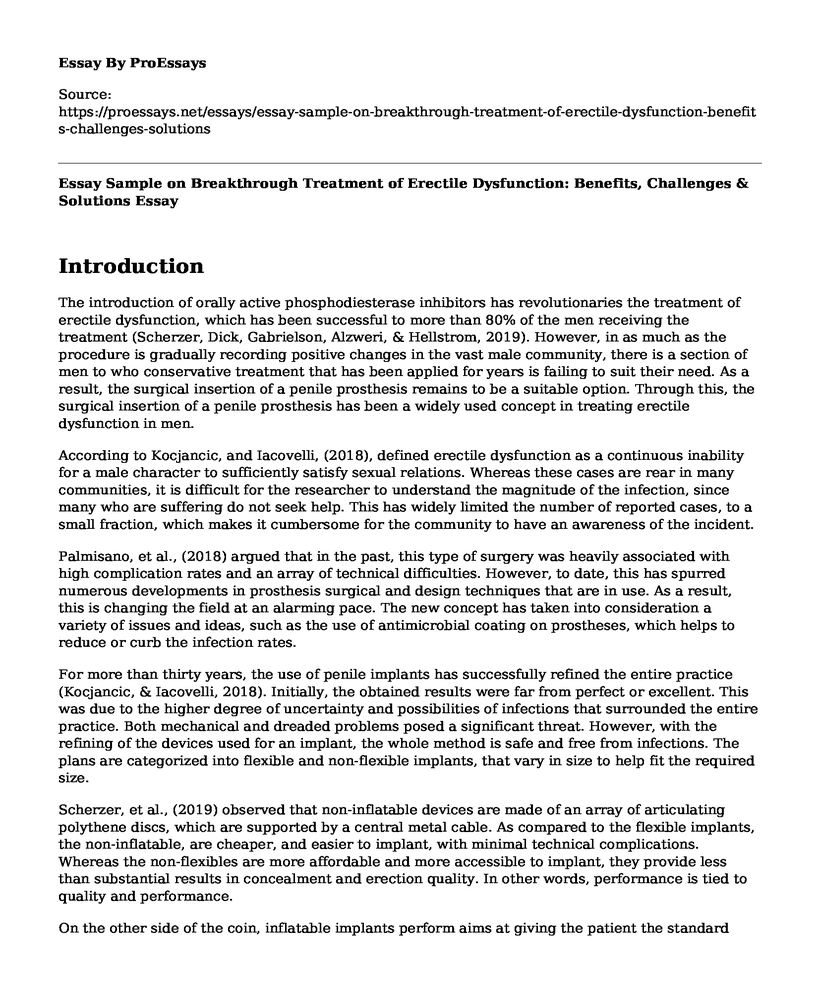Introduction
The introduction of orally active phosphodiesterase inhibitors has revolutionaries the treatment of erectile dysfunction, which has been successful to more than 80% of the men receiving the treatment (Scherzer, Dick, Gabrielson, Alzweri, & Hellstrom, 2019). However, in as much as the procedure is gradually recording positive changes in the vast male community, there is a section of men to who conservative treatment that has been applied for years is failing to suit their need. As a result, the surgical insertion of a penile prosthesis remains to be a suitable option. Through this, the surgical insertion of a penile prosthesis has been a widely used concept in treating erectile dysfunction in men.
According to Kocjancic, and Iacovelli, (2018), defined erectile dysfunction as a continuous inability for a male character to sufficiently satisfy sexual relations. Whereas these cases are rear in many communities, it is difficult for the researcher to understand the magnitude of the infection, since many who are suffering do not seek help. This has widely limited the number of reported cases, to a small fraction, which makes it cumbersome for the community to have an awareness of the incident.
Palmisano, et al., (2018) argued that in the past, this type of surgery was heavily associated with high complication rates and an array of technical difficulties. However, to date, this has spurred numerous developments in prosthesis surgical and design techniques that are in use. As a result, this is changing the field at an alarming pace. The new concept has taken into consideration a variety of issues and ideas, such as the use of antimicrobial coating on prostheses, which helps to reduce or curb the infection rates.
For more than thirty years, the use of penile implants has successfully refined the entire practice (Kocjancic, & Iacovelli, 2018). Initially, the obtained results were far from perfect or excellent. This was due to the higher degree of uncertainty and possibilities of infections that surrounded the entire practice. Both mechanical and dreaded problems posed a significant threat. However, with the refining of the devices used for an implant, the whole method is safe and free from infections. The plans are categorized into flexible and non-flexible implants, that vary in size to help fit the required size.
Scherzer, et al., (2019) observed that non-inflatable devices are made of an array of articulating polythene discs, which are supported by a central metal cable. As compared to the flexible implants, the non-inflatable, are cheaper, and easier to implant, with minimal technical complications. Whereas the non-flexibles are more affordable and more accessible to implant, they provide less than substantial results in concealment and erection quality. In other words, performance is tied to quality and performance.
On the other side of the coin, inflatable implants perform aims at giving the patient the standard performance and flexibility of the penile organ. This allows penile girth when in use and subsequently flaccidity, when not in use. Through this, patients can experience both flaccidity and length expansion during erections. The commonly used inflatable implant includes a three-piece device that constitutes a pump fluid, penile cylinders, and a reservoir. The combination of these three parts helps to give the patient, maximum performance, and adjust, with the current situation of the patient.
Conclusion
In the bottom line, the ultimate conclusion is that inflation penile prosthesis is a topic that has not been widely exploited to help create awareness. This has resulted in low reporting of these cases. However, this topic opens the medical practitioners to help encourage male subjects who are undergoing this problem to help cure their situation. Patients can choose between the two categories, depending on their condition and budget.
References
Kocjancic, E., & Iacovelli, V. (2018). Penile prostheses. Clinics in plastic surgery, 45(3), 407-414. Doi: 10.1016/j.cps.2018.03.012
Palmisano, F., Boeri, L., Cristini, C., Antonini, G., Spinelli, M. G., Franco, G., ... & Montanari, E. (2018). Comparison of infrapubic vs penoscrotal approaches for 3-piece inflatable penile prosthesis placement: Do we have a winner? Sexual medicine reviews, 6(4), 631-639.doi: 10.1016/j.sxmr.2018.03.007
Scherzer, N. D., Dick, B., Gabrielson, A. T., Alzweri, L. M., & Hellstrom, W. J. (2019). Penile prosthesis complications: planning, prevention, and decision making. Sexual medicine reviews, 7(2), 349-359. Doi: 10.1016/j.sxmr.2018.04.002
Cite this page
Essay Sample on Breakthrough Treatment of Erectile Dysfunction: Benefits, Challenges & Solutions. (2023, Feb 22). Retrieved from https://proessays.net/essays/essay-sample-on-breakthrough-treatment-of-erectile-dysfunction-benefits-challenges-solutions
If you are the original author of this essay and no longer wish to have it published on the ProEssays website, please click below to request its removal:
- Essay Sample on Gastric Surgery: A Conventional Approach for Weight-Loss
- Unlocking My Unique Walking Style to Learn New Moves - Essay Sample
- Mothers' PRA Linked to Infants' Brain Responses to Sad Speech - Research Paper
- COVID-19: 3.11M Cases, 217K Deaths and Counting - Essay Sample
- Essay Example on Nutrition: Essential Nutrients for Optimal Health
- Group Singing: Benefits to Mental & Physical Health - Essay Sample
- Nurses' Collective Bargaining: Protecting Rights Since 1935 - Free Report Example







